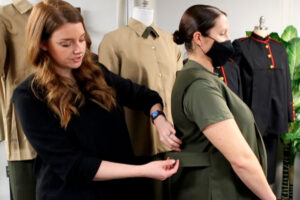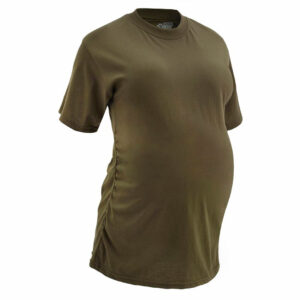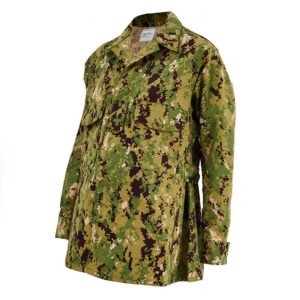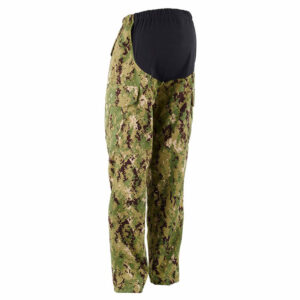Fashion designers are problem solvers, but often, their challenges involve creating comfortable jeans or supportive bras. The stakes are higher for Emily Madden: She’s tasked with preparing pregnant women for combat.
Madden is a clothing designer in the Army, whose department is tasked with creating clothes for all branches of the armed forces. Over the past four years, she’s supported the Marine Corps by creating garments for female Marines. Many servicewomen’s uniforms haven’t been updated in half a century, but as women take on greater responsibility in the military–occasionally while pregnant or breastfeeding–this design squad is creating the garments they need to do their jobs well.

Pregnant Soldiers Speak Up
Before joining the Army, Madden was a traditional fashion designer. After earning a degree in apparel design from the University of Wisconsin, she worked for Kohl’s and other large brands. But when she saw a job posting for this design role in the U.S. Army Combat Capabilities Development Command Soldier Center, Madden thought she could use her skills to serve her country. “My background was in understanding how fabrics work and drape based on how you move,” she says. “It lends itself very well to a position of this kind.”
She arrived at an interesting moment in the military’s history. Women have been serving in the armed forces since 1948, but in the early years, they were largely relegated to administrative roles. In the 1970s, women were allowed to enter military service academies and fight, but it wasn’t until the 1990s that they were allowed to fly combat missions or serve on combat ships. At each of these turning points, the army made uniforms for women, but most have not been significantly updated in decades, according to Madden.
But things are beginning to change, partly because women are demanding it. There are still many issues holding military women back including sexual harassment and assault, but you’ll also find more women than ever in combat roles and being promoted into leadership positions. This shift is empowering women to speak up about their needs, which is leading to change.
The Army, for instance, is now developing a tactical bra so servicewomen don’t need to buy off-the-shelf sports bras. Madden isn’t part of this project, but designers across all branches of the armed forces share ideas; she may eventually borrow part of the design for a Marine Corp bra.
Meanwhile in the Marines, servicewomen are demanding clothes designed specifically for pregnancy. Three years ago, Major Desiree Sanchez was the aide-de-camp for the assistant commandant of Marines when she discovered she was pregnant. As her pregnancy progressed, her peers would dress in blue uniforms that Marines use for special ceremonies, but hers no longer fit. She was stuck wearing the everyday khaki uniform called a “pickle” uniform, whose waistband happened to accommodate her growing belly.

The Expanding Marine Uniform
Madden’s team is now working to adapt 11 different uniforms within the Marine’s portfolio to make them pregnancy and breastfeeding friendly. While pregnant women make up a small proportion of the armed forces, they have been increasingly given more responsibility. Women in the Air Force, for instance, have recently been cleared to fly into combat into their third trimester. And Madden points out that having ill-fitting garments can make it hard for pregnant servicewomen to move comfortably or think on their feet.
Rather than create garments for each stage of pregnancy, the team’s goal is to create a collection of uniforms that expands and contracts from pregnancy into the postpartum period, when women’s bodies are recovering. This tactic aligns with trends in the maternity-wear industry, as many women don’t want to buy more clothes than necessary. And from the Army’s perspective, this approach makes good financial sense. “Part of our mandate is to make the most effective use of taxpayer dollars,” Madden says.
To create these new pieces, the designers studied the current maternity fashion market, exploring brands like Motherhood Maternity. These days, maternity brands incorporate stretchy, compression fabrics originally designed for activewear into many garments, including jeans and leggings. Madden’s team uses similar fabric to update marine uniforms to create 360 belly panels in the skirts and trousers of blue dress uniforms and the khaki uniforms.


Each piece was wear-tested on women in the Marines who are at various stages of pregnancy, including in the third trimester. “We want the pieces to be non-restrictive, so they can grow with you,” Madden says. “But we also heard from these women that they wanted the outfits to look sharp and flattering. They need to be proud of their uniforms.”
The team is also thinking about postpartum needs. Madden says that many women struggle to breastfeed or pump milk in their current uniforms, and some buy off-the-shelf nursing t-shirts and tank tops to use for the task. Her team has launched a nursing t-shirt that looks identical to the ones that their peers wear. On the top, there are two slits on the right and left that provide easy access for breastfeeding or pumping, but when they are buttoned it looks just like a t-shirt. “It has a very simple design, which reduces cost,” says Madden. “We looked for a very cotton poly blend that still provided the look as a regular t-shirt.”
Madden’s team turned around these prototypes in months. But manufacturing them was another challenge. All military uniforms must be made domestically, but many local manufacturers have had supply chain challenges during the pandemic. While the first uniforms came out in April of this year, more are still being manufactured.
“We want to be there for them from the moment they find out they are pregnant all the way to 39 weeks,” she says. “We want to make sure that no pregnant servicewoman is uncomfortable as she goes into work to serve her country.”
Chcete-li přidat komentář, přihlaste se
Ostatní příspěvky v této skupině

It has, to date, been a calm hurricane season in the state of Florida, but any resident of the Southeast will tell you that the deeper into summer we go, the more dangerous it becomes.
T

TikTok has become obsessed with an alleged shoplifter who spent seven straight hou

Apple says the upcoming iOS 26, expected in a polished “release” version in September, will support devices back to the iPhone 11 from September 2019 and second-generation iPhone SE from April 202

“India is on the moon,” S. Somanath, chairman of the Indian Space Research Organization, announced in


Good news: Vine might be coming back. Bad news: in AI form, courtesy o

A stable “release” version of Apple’s iOS 26 is due in September, but you can now try an in-progress version, called the public beta. It previews a revamped interface and new fea
